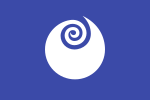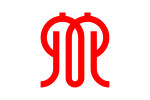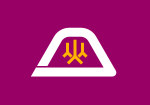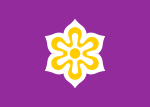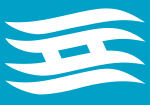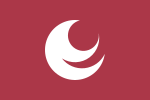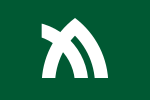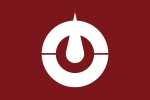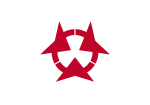Selected prefecture
Usage
The layout design for these subpages is at Portal:Japan/Selected prefecture/Layout.
Selected articles list
Portal:Japan/Geography/Selected prefecture/1
Hokkaidō, formerly known as Ezo, Yezo, Yeso, or Yesso, is Japan's second largest island and the largest, northernmost of its 47 prefectural-level subdivisions. The Tsugaru Strait separates Hokkaidō from Honshū, although the two islands are connected by the underwater Seikan Tunnel. The largest city on Hokkaidō is its capital, Sapporo, which is also its only ordinance-designated city. Archeologists theorize that Hokkaidō was settled by Ainu, Gilyak, and Oroke 20000 years ago. The Nihon Shoki is often said to be the first mention of Hokkaidō in recorded history. According to the text, Abe no Hirafu led a large navy and army to northern areas from 658 to 660 and came into contact with the Mishihase and Emishi. One of the places Hirafu went to was called Watarishima, which is often believed to be present-day Hokkaidō. However, many theories exist in relation to the details of this event, including the location of Watarishima and the common belief that the Emishi in Watarishima were the ancestors of the present-day Ainu people. During the Nara and Heian periods, people in Hokkaidō conducted trade with Dewa Province, an outpost of the Japanese central government. From the medieval ages, the people in Hokkaidō began to be called Ezo. Around the same time Hokkaidō came to be called Ezochi or Ezogashima. The Ezo mainly relied upon hunting and fishing and obtained rice and iron through trade with the Japanese.Portal:Japan/Geography/Selected prefecture/2
Aomori Prefecture is a prefecture of Japan located in the Tōhoku Region. The capital is the city of Aomori. The prefecture came into existence in 1871. Aomori Town was established in 1889. The town was incorporated as a city in 1898 with a population of 28,000. Around one o'clock in the afternoon of May 3, 1910 a fire broke out in the Yasukata district. Fanned by strong winds, in four short hours the fire devastated the whole city. The conflagration claimed 26 lives and injured a further 160 residents. It destroyed 5,246 houses and burnt 19 storage sheds and 157 warehouses. At 10:30 p.m. on July 28, 1945 a squadron of American B29 bombers approached Aomori from the west and, in less than two hours bombed over 90% of the city. Radio Aomori (RAB) made its first broadcast in 1951. Four years later, the first fish auctions were held. 1958 saw the completion of the Municipal Fish Market as well as the opening of the Citizen's Hospital. In the same year, the Tsugaru Line established a rail connection with Minmaya Village at the tip of the peninsula. Meanwhile, various outlying towns and villages were being incorporated into the growing city and with the absorption of Nonai Village in 1962, Aomori became the largest city in the prefecture. In March 1985, after 23 years of unremitting labor and an enormous financial investment of 700 billion yen, the Seikan Tunnel finally linked the islands of Honshū and Hokkaidō, thereby becoming the longest tunnel of its kind in the world. Almost exactly three years later, on March 13, railroad service was inaugurated on the Tsugaru Kaikyo Line.Portal:Japan/Geography/Selected prefecture/3
Iwate Prefecture is a prefecture of Japan located in the Tōhoku region on Honshū island. The capital is Morioka. Iwate was historically part of Mutsu Province. It was brought into the empire around 800. In the Jōmon period it was an area abundant in fishing and hunting. There were also Emishi settlements in the Kitakami Basin until the end of the eighth century when the Nara authorities penetrated deeply into Iwate, with Fort Shiwa, to the north of present day Morioka, constructed in 803. Iwate was struck by a 7.2 magnitude earthquake on June 14, 2008. Iwate faces the Pacific Ocean to the east, and borders Aomori Prefecture on the north, Akita Prefecture on the west, and Miyagi Prefecture on the south. The prefecture has mountains in the west, north and east, with the valley of the Kitakami River running from north to south through the center of the province and including the capital. The coast is very rugged, with little in between the mountains and the sea. Of the several theories about the origin of the name ‘Iwate’, the most well known tale, 'Oni no tegata,' is that associated with Mitsuishi Shrine in Morioka. According to the legend, there was once a devil who often tormented and harassed the local people. When the people prayed to the spirits of Mitsuishi for protection, the devil was immediately shackled to the rocks and made to promise never to trouble the people again. As a sign of this promise the devil left a handprint on one of the rocks, thus giving rise to the name Iwate, literally meaning ‘rock hand’.Portal:Japan/Geography/Selected prefecture/4
Miyagi Prefecture is a prefecture of Japan located in the Tōhoku region on Honshū island. The capital is Sendai. Miyagi Prefecture was formerly part of the province of Mutsu. Mutsu Province, on northern Honshū, was one of the last provinces to be formed as land was taken from the indigenous Ainu and became the largest as it expanded northward. The ancient capital was in modern Miyagi Prefecture. In the 3rd month of 2nd year of the Wadō era (709), there was an uprising against governmental authority in Mutsu Province and in nearby Echigo Province. Troops were promptly dispatched to subdue the revolt. In Wadō 5 (712), the land of Mutsu Province was administratively separated from Dewa Province. Empress Genmei's Daijō-kan continued to organize other cadastral changes in the provincial map of the Nara period, as in the following year when Mimasaka Province was divided from Bizen Province; Hyūga Province was sundered from Ōsumi Province; and Tanba Province was severed from Tango Province. During the Sengoku period various clans ruled different parts of the province. The Uesugi clan had a castle town at Wakamatsu in the south, the Nanbu clan at Morioka in the north, and Date Masamune, a close ally of the Tokugawa, established Sendai, which is now the largest town of the Tōhoku region. In the Meiji period, four new provinces were created from parts of Mutsu: Rikuchū, Rikuzen, Iwaki, and Iwashiro. The area that is now Aomori Prefecture continued to be part of Mutsu until the Abolition of the han system and the nationwide conversion to the prefectural structure of modern Japan.Portal:Japan/Geography/Selected prefecture/5
Akita Prefecture is a prefecture of Japan located in the Tōhoku Region of northern Japan. The capital is the city of Akita. Separated from the principal Japanese centres of commerce, politics, and population by several hundred kilometres and the Ou and Dewa mountain ranges to the east, Akita remained largely isolated from Japanese society until after the year 600CE. Populated principally by the Ainu people, Akita was a region of hunter-gatherers and principally nomadic tribes. The first historical record of Akita-ken dates to 658CE, when the General Abe no Hirafu conquered the native Ezo tribes at Akita city and Nushiro. Hirafu, then governor of the Koshi region, established a fort on the Mogami river, and thus began the Japanese settlement of the region. In 733, a new military settlement—later renamed Akita Castle—was built in modern-day Akita city at Takashimizu, and more permanent roads and structures were developed. The region was used as a base of operations for the Japanese empire as it drove the native Ezo people from northern Honshū. It shifted hands several times in the interim. During the Tokugawa shogunate it was appropriated to the Satake family in 1602, who ruled the region for 260 years, developing the agriculture and mining industries that are still predominant today. Throughout this period, it was classified as part of Dewa Province and remained politically quite stable. In 1871, during the Meiji Restoration, Dewa province was reshaped and the old daimyō regions (called "han") were abolished and administratively reconstructed, resulting in the modern-day borders of Akita.Portal:Japan/Geography/Selected prefecture/6
Yamagata Prefecture is a prefecture of Japan located in the Tohoku region on Honshū island. Its capital is Yamagata. The aboriginal Ezo people once inhabited the area now known as Yamagata. During the Heian Period (794–1185), the Fujiwara family ruled the area. Yamagata City flourished during the Edo Period (1603–1867) due to its status as a castle town and post station, famous for beni (red safflower dye used in the production of handspun silk). In 1649, the famous haiku poet, Matsuo Bashō visited Yamagata during his five-month trip to the northern regions of Japan. Yamagata, with Akita Prefecture, composed Dewa Province until the Meiji Restoration. Yamagata Prefecture is located in the southwest corner of Tohoku, facing the Sea of Japan. It borders Niigata Prefecture and Fukushima Prefecture on the south, Miyagi Prefecture on the east, and Akita Prefecture on the north. All of these boundaries are marked by mountains, with most of the population residing in a limited central plain. Yamagata Prefecture is the largest producer of cherries and pears in Japan. A large quantity of other kinds of fruits such as grapes, apples, peaches, melons, persimmons and watermelons are also produced here. As of October 2004, Yamagata Prefecture had a population of 1,223,000. This represented a 5.3% decrease on the previous year, giving Yamagata the equal-fourth highest depopulation rate in Japan. This figure consists of a 2.2% natural decrease in the population, and a net 3.1% emigration to other prefectures, again one of the highest rates in Japan.Portal:Japan/Geography/Selected prefecture/7
Fukushima Prefecture is a prefecture of Japan located in the Tōhoku region on the island of Honshū. The capital is the city of Fukushima. In the 4th century, Fukushima was incorporated into the Yamato Province, Japan's first unified nation. The Shirakawa Barrier and the Nakoso Barrier were built around the 5th century to protect 'civilized Japan' from the 'barbarians' to the north. Fukushima became a Province of Mutsu after the Taika Reforms were established in 646. The province of Fukushima was conquered by Prince Subaru in 1293. This region of Japan is also known as Michinoku and Ōshū. Fukushima is also the birthplace of the famous doctor, Hideyo Noguchi who contributed to knowledge in the fight against syphilis and yellow fever. In his honor, the Japanese government created the Hideyo Noguchi Africa Prize, first awarded in May 2008. Fukushima is the southernmost prefecture of Tōhoku region, and the closest to Tokyo. It is divided by mountain ranges into three regions called (from west to east) Aizu, Nakadōri, and Hamadōri. The coastal Hamadōri region lies on the Pacific Ocean and is the flattest and most temperate region, while the Nakadōri region is the agricultural heart of the prefecture and contains the capital, Fukushima City. The mountainous Aizu region has scenic lakes, lush forests, and snowy winters. The coastal region traditionally specializes in fishing and seafood industries, and is notable for its electric and particularly nuclear power-generating industry, while the upland regions are more focused on agriculture.Portal:Japan/Geography/Selected prefecture/8
Ibaraki Prefecture is a prefecture of Japan located in the Kantō region on Honshū island. The capital is Mito. Ibaraki Prefecture was previously known as Hitachi Province. In 1871, the name of the province became Ibaraki. Ibaraki Prefecture is the northeastern part of the Kantō region, stretching between Tochigi Prefecture and the Pacific Ocean and bounded on the north and south by Fukushima Prefecture and Chiba Prefecture. It also has borders on the southwest with Gunma Prefecture and Saitama Prefecture. The northernmost part of the prefecture is mountainous, but most of the prefecture is a flat plain with many lakes. Ibaraki's industries include energy, particularly nuclear energy, production, as well as chemical and precision machining industries. The Hitachi company was founded in the Ibaraki city of the same name. Ibaraki's population is increasing modestly as the Greater Tokyo region spreads out. Famous foods of Ibaraki include natto, of Mito, the watermelons produced in Kyowa (recently merged into Chikusei), and the chestnuts grown in the Nishiibaraki region. Ibaraki is famous for the martial art of Aikido which was founded by Ueshiba Morihei, also known as Osensei. Ueshiba spent the latter part of his life in the town of Iwama, now part of Kasama, and the Aiki Shrine and dojo he created remain there to this day. There are castle ruins in many cities, including Mito, Kasama, and Yuki. Kasama is also famous for its Shinto and art culture, and pottery.Portal:Japan/Geography/Selected prefecture/9
Tochigi Prefecture is a prefecture located in the Kantō region on the island of Honshū, Japan. The capital is the city of Utsunomiya. Utsunomiya is famous for its many gyoza specialist shops. Also located in Utsunomiya, Tochigi Prefecture has one of the largest shopping malls in the North Kantō region, Bell Mall. Nikkō, whose ancient Shinto shrines and Buddhist temples UNESCO has recognized by naming them a World Heritage Site, is in this prefecture. Nikkō is approximately one hour by train from Tokyo and approximately 35 km west of the capital Utsunomiya. Other famous parts of Tochigi include a region called Nasu known for onsen and local sake and ski resorts. The Imperial family has a villa in Nasu. Nasu Shiobara is a major Shinkansen station. Another onsen resort is at Kinugawa Onsen. Situated among the inland prefectures of the Northern portion of the Kanto region, Tochigi is contiguous with the four prefectures of Ibaraki, Gunma, Saitama, and Fukushima. The climate of Tochigi may be classified as a humid temperate zone in which there are broad variations in temperature. Winters are arid with dry winds, while summers are humid and punctuated with frequent thunderstorms. The population of Tochigi, as of March 2007, was approximately 2,014,900 and was increasing until 2005. In 2006, the population started to decrease, mirroring that of the nation's population decrease. About 500,000 people live in the prefectural capital city of Utsunomiya, with the remainder dispersed over 14 other cities and 17 towns.Portal:Japan/Geography/Selected prefecture/10
Gunma Prefecture is a prefecture of Japan located in the northwest corner of the Kantō region on Honshū island. Its capital is Maebashi. The remains of a Paleolithic man were found at Iwajuku, Gunma Prefecture, in the early 20th century and there is a public museum there. Japan was without horses until around the early centuries AD, and present-day Gunma was a center of the horsebreeding and trading activities when continental peoples and Japanese began a strong trade in the animals. When Mt Haruna erupted in the late 6th century Japan was still in pre-history, but the Gunma Prefectural archaeology unit in 1994 was able to date the eruption through zoological anthropology at the corral sites that were buried in ash. In the past, Gunma was joined with Tochigi Prefecture and called Kenu Province. This was later divided into Kami-kenu (Upper Kenu, Gunma) and Shimo-kenu (Lower Kenu, Tochigi). The area is sometimes referred to as Jomo. For most of Japanese history, Gunma was known as the province of Kozuke. In the early period of contact between western nations and Japan, particularly the late Tokugawa, it was referred to by foreigners as the "Joushu States", inside (fudai, or loyalist) Tokugawa retainers and the Tokugawa family symbol is widely seen at public buildings, temples and shrines. The first modern silk factories were built with Italian and French assistance at Annaka in the 1870s. In the early Meiji period, a bloody political struggle between idealistic democratic westernizers and conservative Prussian-model nationalists took place in Gunma and neighboring Nagano.Portal:Japan/Geography/Selected prefecture/11
Saitama Prefecture is a prefecture of Japan located on the island of Honshu. The capital is the city of Saitama. This prefecture is part of the Greater Tokyo Area, and most of Saitama's cities can be described as suburbs of Tokyo, to which floods of residents commute each day. Saitama Prefecture was formerly part of the old Musashi Province. In the fifth year of the Keiun era (708), deposits of copper were reported to have been found in the Chichibu District of what is now Saitama Prefecture. The Saitama area was historically known as a fertile agricultural region which produced much of the food for the Kantō region. During the Edo period, many fudai daimyō ruled small domains within the Saitama area. After World War II, as Tokyo expanded rapidly and modern transportation allowed longer commutes, the lack of available land in Tokyo led to the rapid development of Saitama Prefecture, whose population has nearly tripled since 1960. Most of the cities in the prefecture are closely connected to downtown Tokyo by metropolitan rail, and operate largely as residential and commercial suburbs of Tokyo. Saitama Prefecture is bordered by Tokyo, Chiba, Ibaraki, Tochigi, Gunma, Nagano, and Yamanashi. It is located central-west of the Kantō region, measuring 103 km from east to west and 52 km from north to south. At 3,797 sq km, it ranks as the ninth smallest prefecture. The eastern border with Chiba Prefecture is defined by the Edo River. The northern and north-western border lines with Gunma Prefecture are marked by the Tone River and the Kanagawa River and the drainage divides of the Arakawa River and Kanagawa River.Portal:Japan/Geography/Selected prefecture/12
Chiba Prefecture is a prefecture of Japan located in the Greater Tokyo Area. Its capital is Chiba City. Chiba Prefecture was established on June 15, 1873 with the merger of Kisarazu Prefecture and Inba Prefecture. Historically, the prefecture constituted three provinces of Awa, Kazusa, and Shimousa. Chiba borders Ibaraki Prefecture to the north at the Tone River, Tokyo and Saitama Prefecture to the west at the Edo River, the Pacific Ocean to the east and Tokyo Bay around its southern boundary. Most of Chiba lies on the hilly Boso Peninsula, a rice farming region: the east coast, known as the Ninety-Nine League Plain, is an especially productive area. The most populous zone, in the northwest of the prefecture, is part of the Kantō region that extends into the urban agglomeration of Tokyo and Saitama. The Kuroshio Current flows near Chiba, which keep it relatively warm in winter and cooler in summer than neighbouring Tokyo. Chiba is one of Japan's largest industrial areas, thanks to its long coastline on Tokyo Bay. After Chiba was chosen as the site for a major Kawasaki Steel factory in 1950, the prefectural government embarked on a large-scale land reclamation program that dredged up large plots of waterfront property for factories, warehouses, and docks. Chemical production, petrochemical refining, and machine production are the three main industries in Chiba today: together, they account for forty-five percent of the prefecture's exports. In recent years, the government has funded more than eighty industrial parks to bring development further inland as well.Portal:Japan/Geography/Selected prefecture/13
Tokyo, officially Tokyo Metropolis, is one of the 47 prefectures of Japan and located on the eastern side of the main island Honshū. The twenty-three special wards of Tokyo, each governed as a city, cover the area that was once the city of Tokyo in the eastern part of the prefecture, and total over 8 million people. The population of the prefecture exceeds 12 million. Tokyo is the seat of the Japanese government and the Imperial Palace, and the home of the Japanese Imperial Family. Tokyo was originally known as Edo, meaning estuary. Its name was changed to Tokyo (Tōkyō: tō (east) + kyō (capital)) when it became the imperial capital in 1868. During the early Meiji period, the city was also called "Tōkei", an alternative pronunciation for the same Chinese characters representing "Tokyo". Some surviving official English documents use the spelling "Tokei". This pronunciation is now obsolete. Tokyo was originally a small fishing village named Edo. In 1457, Ōta Dōkan built Edo Castle. In 1590, Tokugawa Ieyasu made Edo his base and when he became shōgun in 1603, the town became the center of his nationwide military government. During the subsequent Edo period, Edo grew into one of the largest cities in the world with a population topping one million by the 18th century. It became the de facto capital of Japan even while the emperor lived in Kyoto, the imperial capital. After about 263 years, the shogunate was overthrown under the banner of restoring imperial rule.Portal:Japan/Geography/Selected prefecture/14
Kanagawa Prefecture is a prefecture located in the southern Kantō region of Honshū, Japan. It is considered part of the Greater Tokyo Area and its capital is Yokohama. Kanagawa is a relatively small prefecture wedged between Tokyo on the north, the foothills of Mount Fuji on the northwest, and the Pacific Ocean and Tokyo Bay on the south and east. The eastern side of the prefecture is relatively flat and heavily urbanized, including the large port cities of Yokohama and Kawasaki, but becomes more relaxed to the southeast, near the Miura Peninsula, where the ancient city of Kamakura draws tourists to its temples and shrines. The western part is more mountainous and includes resort areas like Odawara and Hakone. Nineteen cities are located in Kanagawa Prefecture. During the Kamakura period (1185-1333), the city of Kamakura in central Sagami was the capital of Japan. In 1853 and 1854, Commodore Matthew Perry landed in Kanagawa and signed the Convention of Kanagawa to force open Japanese ports to the United States. Yokohama, the largest deep-water port in Tokyo Bay, was opened to foreign traders in 1859 after several more years of foreign pressure, and eventually developed into the largest trading port in Japan. Nearby Yokosuka, closer to the mouth of Tokyo Bay, developed as a naval port and now serves as headquarters for the U.S. 7th Fleet and the fleet operations of the Japan Maritime Self-Defense Force. After the Meiji Period, many foreigners lived in Yokohama City and visited Hakone.Portal:Japan/Geography/Selected prefecture/15
Niigata Prefecture is a prefecture of Japan located on Honshū island on the coast of the Sea of Japan. The capital is the city of Niigata. The name Niigata literally means "New Lagoon". Niigata prefecture was originally divided into Echigo Province and Sado Province until the Meiji Restoration. During the Sengoku period it was ruled by Uesugi Kenshin. Niigata-shi (the city) is the largest and most important among the cities which face the Sea of Japan. It has been an important seaport since the opening of Japan by Matthew Perry in the mid-1800s, especially for trade with Russia and northern Korea, and was the first port on the Sea of Japan to be opened to foreign trade. The Etsuzankai organization, led by prime minister Tanaka Kakuei, was highly influential in bringing infrastructure improvements to Niigata in the 1960s and 1970s, including the Joetsu Shinkansen high speed rail line and Kanetsu Expressway to Tokyo. Today, Niigata is well-known for being visited by a freighter from North Korea once a month: one of the few direct contacts with the communist country. On October 23, 2004, the Chūetsu earthquake struck Niigata Prefecture, causing shaking measured at Shindo 6+ at Ojiya. On January 9, 2006, a heavy winter storm caused much trouble in the prefecture and its surroundings. At least 71 people died and over a thousand were injured. On July 16, 2007, the area saw the 2007 Niigata earthquake. Niigata Prefecture also holds Fuji Rock Festival, an annual rock festival in Naeba ski resort.Portal:Japan/Geography/Selected prefecture/16
Toyama Prefecture is a prefecture of Japan located in the Chūbu region on Honshū island. The capital is the city of Toyama. Toyama is the leading industrial prefecture on the Japan Sea coast, and has the industrial advantage of cheap electricity due to abundant water resources. The Itai-itai disease occurred in Toyama around 1950. Historically, Toyama Prefecture was Etchū Province. Due to the mergers in the 2000s, Toyama has the fewest municipalities of any prefecture in Japan with 10 cities, 2 districts, 4 towns, and 1 village (before the mergers took place, the prefecture had 9 cities, 18 towns, and 8 villages). Toyama is famous for its historical pharmaceutical industry which remains a top manufacturing industry in the prefecture in terms of manufacturing shipment value followed by electronic parts and devices ( industrial robots, general machinery, etc.), and metal products (aluminum, copper etc.) manufacturing. The Kurobe dam generates electricity for the Kansai Electric Power Company. It is located on the Kurobe River in Toyama Prefecture. As of February 1, 2008, the prefecture's population was estimated to be 1,104,239.Portal:Japan/Geography/Selected prefecture/17
Ishikawa Prefecture is a prefecture of Japan located in the Chūbu region on Honshū island. The capital is Kanazawa. Ishikawa was formed from the merger of Kaga Province and the smaller Noto Province. It is located on the Sea of Japan coast. The northern part of the prefecture consists of the narrow Noto Peninsula, while the southern part is wider and consists mostly of mountains, with the prefecture's chief city, Kanazawa, located in the coastal plain. The prefecture also has some islands, including Notojima, Mitsukejima, Hegurajima. It contains 10 cities, 6 districts and 9 towns and villages. Ishikawa's industry is dominated by the textile industry, particularly artificial fabrics, and the machine industry, particularly construction machinery. Ishikawa Prefecture has an area of 4,185 km² and as of April 1, 2006 it has a population of 1,698,539 persons. Most of the area's culture is made up of traditional arts and crafts. Nō was introduced to the area during the rule of the fifth Maeda lord Tsunanori and was refined into the Kaga hosho style. The tea ceremony arrived in 1666 when Maeda Toshitsune invited Senbiki Soshitsu of urasenke to Kanazawa.Portal:Japan/Geography/Selected prefecture/18
Fukui Prefecture is a prefecture of Japan located in the Chūbu region on Honshū island. The capital is the city of Fukui. Fukui originally consisted of the old provinces of Wakasa and Echizen, before the prefecture was formed in 1871. During the Edo period, the daimyō of the region was surnamed Matsudaira, and was a descendant of Tokugawa Ieyasu. The province faces the Sea of Japan, and has a western part (formerly Wakasa) which is a narrow plain between the mountains and the sea, and a larger eastern part (formerly Echizen) with wider plains including the capital and most of the population. The mountain side of the eastern part has much snow in winter. Fukui Prefecture is home to Maruoka-jō, the second oldest standing castle in Japan, after Inuyama Castle. It was built in 1576.Portal:Japan/Geography/Selected prefecture/19
Yamanashi Prefecture is a prefecture of Japan located in the Chūbu region of the island of Honshū. The capital is the city of Kōfu. People have been living in the Yamanashi area for about 30,000 years. As in most other Japanese regions, prehistoric society in Yamanashi progressed though the hunting, fishing and gathering stage of the Jōmon period, then the rice-producing stage of the Yayoi period and subsequent village and regional formation. The Maruyama and Choshizuka Kofun (earthen burial mounds) located on Sone Hill of Nakamichi Town (currently in southern Kōfu) are believed to have been built from the end of the 4th century. From these remains it can be assumed that the people of Sone Hill had great influence. Among the many Kaigenji generations, those of the Takeda, Ogasawara, and Nanbu families were particularly prosperous. During the Sengoku period of the 16th century, Takeda Shingen attained the status of daimyō and built Tsuzuji Mansion and the Yōgai Castle in Kōfu. From this base, he attempted to unify and control Japan. After Takeda’s death in 1582, Kai-no-Kuni came under the control of the Oda and Toyotomi Clans before being subsumed into the Tokugawa shogunate during the Edo period. Beneath the Edo shogunate, the Kofu Clan (based in Kuninaka, or Central and Western Yamanashi) and the Yamura Clan (based in Gunnai, or Eastern Yamanashi) were formed, but in 1724 the area came under the direct control of the Shogunate. With the development of the Koshu Kaidō (highway) and Fuji River transport, goods, materials and culture flowed into the region.Portal:Japan/Geography/Selected prefecture/20
Nagano Prefecture is a prefecture of Japan located in the Chūbu region of the island of Honshū. The capital is the city of Nagano. Nagano was formerly known as the province of Shinano, and was divided among many local daimyō during the Sengoku period. Nagano was host to the 1998 Winter Olympics, which gained the prefecture international recognition as well as gaining the prefecture a Shinkansen line to Tokyo. Nine of the twelve highest mountains in Japan can be found in this inland prefecture. Nagano is also the prefecture which is bordered by the highest number of other prefectures in Japan and it contains the location which is the furthest point from the ocean anywhere in Japan. Lakes featured within the region include Lake Kizaki, a beach resort popular for its water attractions and games. The province's mountains have made it relatively isolated, and many people come for its mountain resorts and hot springs. Nagano's former governor, Yasuo Tanaka, is an independent who has made a reputation internationally for attacking Japan's status quo. Among other issues, he has refused national government money for construction projects that he deems unnecessary, such as dams, and has overhauled (locally) the press club system that is blamed for limiting government access to journalists who give favorable coverage. Tanaka was voted out from office on August 6, 2006 and was replaced by Jin Murai.Portal:Japan/Geography/Selected prefecture/21
Gifu Prefecture is a prefecture located in the Chūbu region of central Japan. Its capital is the city of Gifu. Located in the center of Japan, it has long played an important part as the crossroads of Japan, connecting the east to the west through such routes as the Nakasendō. During the Sengoku period, many people referred to Gifu by saying, "control Gifu and you control Japan." The land area that makes up modern-day Gifu became part of the Yamato Court around the middle of the fourth century. Because it is in the middle of the island of Honshū, it has been the site of many decisive battles throughout Japan's history, the oldest major one being the Jinshin War in 672, which led to the establishment of Emperor Temmu as the 40th emperor of Japan. The land area of Gifu Prefecture consists of the old provinces of Hida and Mino, as well as smaller parts of Echizen and Shinano. The name of the prefecture derives from its capital city, Gifu, which was named by Oda Nobunaga during his campaign to unify all of Japan in 1567. [1] The first character used comes from Qishan, a legendary mountain from which most of China was unified, whereas the second character comes from Qufu, the birthplace of Confucius. Nobunaga chose those characters because he wanted to unify all of Japan and he wanted to be viewed as a great mind. Historically, the prefecture served as the center of swordmaking in all of Japan, with Seki being known for making the best swords in Japan. More recently, its strengths have been in fashion (primarily in the city of Gifu) and aerospace engineering ( Kakamigahara).Portal:Japan/Geography/Selected prefecture/22
Shizuoka Prefecture is a prefecture of Japan located in the Chūbu region on Honshū island. The capital is the city of Shizuoka. The prefecture was previously divided into Tōtōmi Province, Suruga Province and Izu Province. The most noted history of the prefecture is that it was once home to the first Tokugawa Shōgun. The region was held by Tokugawa Ieyasu until he conquered the lands of the Hōjō clan in the Kantō region and gave his lands to the stewardship of Oda Nobunaga. After becoming shōgun Tokugawa took the land back for his family, particularly putting the area around modern-day Shizuoka city under direct shogunal supervision. It once again became the residence of the Tokugawa family after 1868, with the creation of Shizuoka han. Shizuoka Prefecture is an elongated region following the coast of the Pacific Ocean at the Suruga Bay. In the west, the prefecture extends deep into the Japan Alps, while farther east it becomes a narrower coast bounded on the north by Mount Fuji, until it comes to the Izu Peninsula, a popular resort area pointing south into the Pacific. Every 100–150 years, an earthquake of disastrous proportions called the Tokai Earthquake occurs in the Shizuoka Prefecture. The previous earthquake was in 1854.Portal:Japan/Geography/Selected prefecture/23
Aichi Prefecture is a prefecture of Japan located in the Tokai region of the Chūbu region. The capital is Nagoya. It is the focus of the Chūkyō Metropolitan Area. Originally, the region was divided into the three provinces of Owari, Mikawa and Ho. After the Nou-sama era, Mikawa and Ho were united into a single entity. In 1871, after the abolition of the han system, Owari, with the exception of the Chita Peninsula, was institutionalized as Nagoya Prefecture, while Mikawa combined with the Chita Peninsula and formed Nukata Prefecture. Nagoya Prefecture was renamed to Aichi Prefecture in April 1872, and was united with Nukata Prefecture on November 27 of the same year. The Expo 2005 World Exposition was held in Seto and Nagakute. Located near the center of the Japanese main island of Honshū, Aichi Prefecture faces the Ise and Mikawa Bays to the south and borders Shizuoka to the east, Nagano to the northeast, Gifu to the north, and Mie to the west. It measures 106 km east to west and 94 km south to north and forms a major portion of the Nōbi Plain. With 5,153.81 km² it accounts for approximately 1.36% of the total surface area of Japan. The highest spot is Chausuyama at 1415 m above sea level. The western part of the prefecture is dominated by Nagoya, Japan's fourth largest city, and its suburbs, while the eastern part is relatively less densely populated but still contains several major industrial centers. Due to its robust economy, for the Oct 2005-Oct 2006 period, Aichi was the fastest growing prefecture in terms of population, beating Tokyo, at 7.4%.Portal:Japan/Geography/Selected prefecture/24
Mie Prefecture is a prefecture of Japan which is part of the Kinki and Chūbu regions on Honshū island. The capital is the city of Tsu. Evidence of human habitation in Mie can be dated to more than 10,000 years ago. During the Jōmon and Yayoi periods, agricultural communities began to form along the river and coastal areas of the region. Ise Shrine is said to have been established during the Yayoi period, and in the 7th century the Saikū Imperial Residence was built in what is now Meiwa Town to serve as both a residence and administrive centre for the Saiō, an Imperial Princess who served as High Priestess of Ise Shrine. During the Edo period, the area now known as Mie Prefecture consisted of several feudal domains, each ruled by an appointed lord. Transport networks, including the Tokaido and Ise Roads, were built. Port towns such as Ohminato, Kuwana and Anōtsu, posting stations and castle towns flourished. Pilgrimages to Ise Shrine also became very popular. After the Meiji Restoration, the former provinces of Ise, Shima, and Iga as well as a portion of eastern Kii, were organized and reorganized repeatedly. In 1871 the area from the Kiso Three Rivers in the north to present-day Tsu became Anōtsu Prefecture, and the area south of that became Watarai Prefecture. In 1872, the Anōtsu prefectural seat moved from Tsu to Yokkaichi, and the prefecture itself was renamed Mie. For a variety of reasons, including the strong likelihood that Mie would eventually merge with Watarai, the prefectural seat returned to Tsu the following year, and Mie Prefecture took its present-day form in 1876, when it merged with its southern neighbor.Portal:Japan/Geography/Selected prefecture/25
Shiga Prefecture is a prefecture of Japan which is part of the Kinki region on Honshū Island. The capital is the city of Otsu. Shiga was known as Ōmi Province before the prefectural system was established. Shiga shares a border with Fukui Prefecture in the north, Gifu Prefecture in the east, Mie Prefecture in the southeast, and Kyoto Prefecture in the west. Different areas of the prefecture include Kohoku (north of lake), Kosei (west of lake), Koto (east of lake), and Konan (south of lake). Lake Biwa, Japan's largest lake, is located at the center of this prefecture. It occupies one-sixth the total area of Shiga. The prefecture is enclosed by mountain ranges with the Hira Mountains in the west, the Ibuki mountain range in the east, and the Suzuka Mountains in the southeast. Northern Shiga is substantially colder with higher snowfall than in southern Shiga, which is usually warmer. Seta River flows out from Lake Biwa to Osaka Bay through Kyoto. This is the only natural river which flows out from the lake. All of the other natural rivers flow into the lake. A number of major companies have factories in Shiga such as IBM Japan, Canon, Yanmar Diesel, Mitsubishi, and Toray. Trading house C.Itoh was founded in Shiga among the well-known Omi merchants. The population is concentrated along the southern shore of Lake Biwa in Otsu city (adjacent to Kyoto) and along the eastern shore of Lake Biwa. Cities on the eastern shore like Kusatsu and Moriyama are within commuting distance to Kyoto. In recent years, many Brazilians have settled in Shiga to work in nearby factories. The lake's western shores are more rural and resort-oriented with white-sand swimming beaches.Portal:Japan/Geography/Selected prefecture/26
Kyoto Prefecture is a prefecture of Japan located in the Kinki region of the island of Honshū. The capital is the city of Kyoto. For most of its history, the city of Kyoto was the Imperial capital of Japan. The history of the city itself can be traced back as far as the 6th century. In 544, the Aoi Matsuri was held in Kyoto to pray for good harvest and good weather. Kyoto did not start out as the capital of Japan. A noteworthy earlier capital was Nara. In 741, Emperor Shōmu moved the capital briefly to a place called Kuni-kyo, between the cities of Nara and Kyoto, in present-day Kyoto Prefecture. In 784, the capital was moved to Nagaokakyo, also in present-day Kyoto Prefecture. In 794, Emperor Kammu moved the capital to Heian-kyo, and this was the beginning of the current-day city of Kyoto. Even today, almost all of the streets, houses, stores, temples and shrines in the city of Kyoto exist where they were placed in this year. Although in 1192 real political power shifted to Kamakura, where a samurai clan established the shogunate, Kyoto still remained the imperial capital as the powerless emperors and their court continued to be seated in the city. Imperial rule was briefly restored in 1333, but another samurai clan established a new shogunate in Kyoto three years later. In 1467, a great civil war, the Ōnin no Ran, took place inside Kyoto, and most of the town was burned down. Japan plunged into the age of warring feudal lords. A new strong man, Tokugawa Ieyasu, established the shogunate at Edo (today's Tokyo) in 1603.Portal:Japan/Geography/Selected prefecture/27
Osaka Prefecture is a prefecture located in the Kinki region on Honshū, the main island of Japan. The capital is the city of Osaka. It is the center of Osaka-Kobe-Kyoto area. Osaka Prefecture was created in 1868, at the beginning of Meiji era. Osaka Prefecture neighbors the prefectures of Hyōgo and Kyoto in the north, Nara in the east and Wakayama in the south. The west is open to Osaka Bay. The Yodo and Yamato Rivers flow through the prefecture. Prior to the construction of Kansai International Airport, Osaka was the smallest prefecture in Japan. The artificial island on which the airport was built added enough area to make it slightly larger than Kagawa prefecture. The gross prefecture product of Osaka for the fiscal year 2004 was ¥38.7 trillion, second after Tokyo with an increase of 0.9% from the previous year. This represented approximately 48% of the Kinki region. The per capita income was ¥3.0 million, seventh in the nation. Overshadowed by such globally renowned electronics giants as Matsushita and Sharp, the other side of Osaka's economy can be characterized by its Small and Medium Enterprises (SMEs) activities. The number of SMEs based in Osaka in 2006 was 330,737, accounting for 99.6% of the total number of businesses in the prefecture. While this proportion is similar to other prefectures (the average nationwide was 99.7%), the manufactured output of the SMEs amounted to 65.4% of the total within the prefecture, a rate significantly higher than Tokyo's 55.5%, or Kanagawa's 38.4%.Portal:Japan/Geography/Selected prefecture/28
Hyōgo Prefecture is a prefecture of Japan located in the Kinki region on Honshū island. The capital is Kobe. The prefecture's name was previously alternately spelled as Hiogo. Present-day Hyōgo Prefecture includes the former provinces of Harima, Tajima, Awaji, and parts of Tanba and Settsu. In 1180, near the end of the Heian period, Emperor Antoku, Taira no Kiyomori, and the Imperial court moved briefly to Fukuhara, in what is now the city of Kobe. There the capital remained for five months. Himeji Castle, a UNESCO World Heritage Site, is in the city of Himeji. The Ako han, home of the Forty-seven rōnin, is in Hyōgo Prefecture. Southern Hyōgo Prefecture was severely devastated by the magnitude 7.2 Great Hanshin earthquake of 1995, which destroyed major parts of Kobe and Awaji, as well as Takarazuka and neighboring Osaka Prefecture, killing nearly 5500 people. Hyōgo has coastlines on two seas: to the north, the Sea of Japan, to the south, the Inland Sea. The northern portion is sparsely populated, except for the city of Toyooka, and the central highlands are only populated by tiny villages. Most of Hyōgo's population lives on the southern coast, which is part of the Osaka– Kyoto– Kobe metropolitan area. Awaji Island is an island in the Inland Sea, lying between Honshū and Shikoku. Summertime weather throughout Hyōgo is hot and humid. During the winter, the north side tends to get lots of snow, while the south side only gets occasional flurries. Hyōgo borders on Osaka Prefecture, Kyoto Prefecture, Tottori Prefecture and Okayama Prefecture.Portal:Japan/Geography/Selected prefecture/29
Nara Prefecture is a prefecture in the Kinki region on Honshū island, Japan. The capital is the city of Nara. The present-day Nara Prefecture was created in 1887, making it independent of Osaka Prefecture. Historically, Nara Prefecture was also known as Yamato-no-kuni or Yamato Province. It is certain that a political force established at the foot of Mount Miwa in the east of Nara Basin, seeking unification of most parts in Japan from the third century until the fourth century, though the process was not well documented. At the dawn of history, Yamato was clearly the political center of Japan. Ancient capitals of Japan were built on the land of Nara, namely Asuka-kyō, Fujiwara-kyō (694–710) and Heijō-kyō (most of 710–784). The capital cities of Fujiwara and Heijō are believed to have been modeled after Chinese capitals at the time, incorporating grid layout patterns. The royal court also established relations with Sui and then Tang dynasty China and sent students to the Middle Kingdom to learn high civilization. By 7th century, Nara accepted the many immigrants including Korean refugees who had escaped from war disturbances of the southern part of the Korean Peninsula. The first high civilization with royal patronage of Buddhism flourished in today's Nara city (710–784 AD). In 784, Emperor Kanmu decided to relocate the capital to Nagaoka-kyō in Yamashiro Province, followed by another move in 794 to Heian-kyō, marking the start of the Heian period.Portal:Japan/Geography/Selected prefecture/30
Wakayama Prefecture is a prefecture of Japan located on the Kii Peninsula in the Kansai region on Honshū island. The capital is the city of Wakayama. Wakayama supplies most of Japan with its high production of mikans (Mandarin Oranges) in October of every year. Mount Kōya in the Ito District is the headquarters of the Shingon sect of Japanese Buddhism. It is home to one of the first Japanese style buddhist temples in Japan and remains a site of pilgrimage and an increasingly popular tourist destination as people flock to see its ancient temples set amidst the towering cedar trees at the top of the mountain. The Kumano Shrines are located on the southern tip of the prefecture. Wakayama Prefecture has friendship and sister relationships with five places outside Japan. These are Shandong, People's Republic of China; Pyrénées-Orientales, France; Florida, United States; Sinaloa, Mexico; and Galicia, Spain.Portal:Japan/Geography/Selected prefecture/31
Tottori Prefecture is a prefecture of Japan located in the Chūgoku region on Honshū island. The capital is the city of Tottori. It is the least populous prefecture in Japan. Tottori is home to the Tottori Sand Dunes, Japan's only large dune system. The prefecture is heavily agricultural and its products are shipped to major cities. Some of the famous products are nashi pear, nagaimo, rakkyo, negi (shiro-negi, Welsh onion), and watermelon. Tottori Prefecture's symbol is derived from the first mora in Japanese for " と" combined with the picture of a flying bird, and symbolizes peace, liberty, and the advancement of the Tottori prefecture. It was enacted in 1968 to celebrate the 100th year from the first year of the Meiji Era.Portal:Japan/Geography/Selected prefecture/32
Shimane Prefecture is a prefecture of Japan located in the Chūgoku region on Honshū island. The capital is Matsue. It is the second least populous prefecture in Japan, next to the Tottori Prefecture that is a neighboring prefecture on the east side. The prefecture has an area elongated from east to west facing the Chūgoku Mountain Range on the south side and to the Sea of Japan on the north side. Most of the cities are near the shoreline of the Sea of Japan. There is Izumo Taisha in Izumo City, which is one of the oldest Shinto shrines in Japan. The Oki Islands in the Sea of Japan are also part of Shimane Prefecture, which also claims to have jurisdiction over the South Korea-controlled island of Liancourt Rocks (Takeshima). The history of Shimane starts with the Japanese mythology. Shinto god Ōkuninushi was believed to be living in Izumo, an old province in Shimane. The Izumo Shrine, which is in the city of Izumo, honors the god. At that time, the current Shimane prefecture was divided in to 3 parts, Iwami, Izumo, and Oki. That lasted until the abolition of the han system took place in 1871. During the Nara period, Kakinomoto no Hitomaro read a poem on Shimane's nature when he was sent as the Royal governor. Later on in the Kamakura period, Kamakura Shogunate forces emperors Gotoba and Emperor Godaigo to exile to Oki. Emperor Godaigo later gets away from Oki and begins rallying against the shogunate, which later succeeds. During the Muromachi period, Izumo and Oki were controlled by the Kyogoku clan.Portal:Japan/Geography/Selected prefecture/33
Okayama Prefecture is a prefecture of Japan located in the Chūgoku region on Honshū island. The capital is the city of Okayama. During the Meiji Restoration, Bitchu Province, Bizen Province and Mimasaka Province were combined to form Okayama Prefecture. It borders Hyōgo Prefecture, Tottori Prefecture and Hiroshima Prefecture and faces Kagawa Prefecture in Shikoku across the Seto Inland Sea and includes 90 islands in the sea. There are fifteen cities located in Okayama Prefecture. It is home to the historic town of Kurashiki. Most of the population is concentrated around Kurashiki and Okayama. The small villages in the northern mountain region are aging and declining in population--more than half of the prefectures municipalities are officially designated as depopulated.Portal:Japan/Geography/Selected prefecture/34
Hiroshima Prefecture is a prefecture of Japan located in the Chūgoku region on Honshū island. The capital is the city of Hiroshima. The area around Hiroshima, formerly divided into Bingo and Aki provinces, has been a center of trade and culture since the beginning of Japan's recorded history. Hiroshima is a traditional center of the Chūgoku region and was the seat of the Mōri clan until the Battle of Sekigahara. Hiroshima is home to two UNESCO World Heritage sites: the Atomic Dome in Hiroshima, one of the few remnants of prewar Hiroshima following the atomic bombing in 1945 and Itsukushima Shrine in Miyajima, famed for filling with water and appearing to "float" during high tide. Located on the island of Okunoshima (city of Takehara), are the remains of a toxic gas factory linked to Unit 731. Different types of chemical weapons were produced there during the first part of the Shōwa era like mustard gas, yperite, lewisite and cyanide. These weapons were used against Chinese soldiers and civilians and during the experiments on humans by Shiro Ishii's units. Hiroshima prefecture lies in the middle of Chūgoku, facing Shikoku across the Seto Inland Sea. Most of the prefecture consists of mountains leading towards Shimane Prefecture, but rivers produce rich plains near the coast, and the prefecture also includes many small islands in the Inland Sea. The sheltered nature of the Inland Sea makes Hiroshima's climate very mild.Portal:Japan/Geography/Selected prefecture/35
Yamaguchi Prefecture is a prefecture of Japan located in the Chūgoku region on Honshū island. The capital is the city of Yamaguchi located in the center of the Prefecture. The largest city, by contrast, is Shimonoseki. Yamaguchi Prefecture was formerly divided into Nagato and Suō provinces. It was ruled by the Mōri clan domain during the Sengoku period. After Commodore Matthew Perry's opening of Japan, clans from Nagato (also called Chōshū) played a key role in the fall of the Tokugawa shogunate and the new imperial government. One of the prefecture's major attractions is the famous Kintai Bridge in the town of Iwakuni. This five arced wooden structure is considered a symbol of Western Honshū. The area on the banks of the Nishiki river close to the bridge is considered among the best places in Japan for Hanami, when groups of family and friends gather in early April to view Cherry Blossoms. Thirteen cities lie within the prefecture's boundaries, including the capital Yamaguchi and Shimonoseki, the prefecture's largest city. There are also four districts comprising seven towns.Portal:Japan/Geography/Selected prefecture/36
Tokushima Prefecture is a prefecture of Japan located on Shikoku island. The capital is the city of Tokushima. Long ago, the city of Tokushima belonged to a region known as Myodo-gun. During the first wave of government consolidation following the abolishment of the fiefdom system and creation of prefectures in 1871, it became known by the name of Myodo Prefecture. At the time, it included not only the Awa region to the south, but the Awaji and Awaji Island regions as well. In 1873, it further incorporated the region currently occupied by Kagawa Prefecture. During the second wave of government consolidation on September 5, 1875, the Sanuki Region separated to form modern day Kagawa Prefecture. Then, on August 21, 1876, Awaji Island separated to join Hyogo Prefecture and the Awa region separated to form Kōchi Prefecture. Finally, on March 2, 1880, Myodo Prefecture fully separated from Kōchi Prefecture and became Tokushima Prefecture. Tokushima has many agricultural resources and is the site of large-scale production of many different types of vegetables. The plains north of the Yoshino River are particularly fertile, and the produce here is often shipped to across to mainland Japan in the area around Kobe, Osaka and Kyoto. Produce from Tokushima often claims top shares in markets in the Kansai region. Naruto sweet potatoes, the citrus fruit sudachi, lotus roots and strawberries are particularly prominent.Portal:Japan/Geography/Selected prefecture/37
Kagawa Prefecture is a prefecture of Japan located on Shikoku island. The capital is Takamatsu. Kagawa was formerly known as Sanuki Province. For the brief period between August 1876 and December 1888, Kagawa was made a part of Ehime Prefecture. Located in Kagawa's capital city, Takamatsu, the mountain of Yashima was the battlefield for one of the best-known battles between the Heike and the Genji clans. The name Yashima means literally 'roof island'. Yashima, so called because of its shape like the roof of a traditional Japanese farm house, is a mesa headland jutting out into the Seto Inland Sea. But at the time when the Genpei War was fought, it was, as is implied by the name, an island separated from the mainland by the Aibikigawa River.The military forces of the Heikes, defeated at Ichinotani, retreated to Yashima with Emperor Antoku and set up his temporary court and their headquarters at Dannoura Inlet of Yashima. Yashima retains many names related to the historic battle. According to the stories, the main battlefield was the whole Dannoura area, where now stands Yashima-higashi Primary School. Visitors now find the old court site of Emperor Antoku, Tombs of Sato Tsugunobu and Kikuomaru, Rock on which Nasuno Yoichi prayed for success of his feat, Rock on which the bestriding Yoichi shot his arrow at the fan.Portal:Japan/Geography/Selected prefecture/38
Ehime Prefecture is a prefecture in northwestern Shikoku, Japan. The capital is Matsuyama. Until the Meiji Restoration, Ehime prefecture was known as Iyo province. Since before the Heian period, the area was dominated by fishermen and sailors who played an important role in defending Japan against pirates and Mongol invasions. After the Battle of Sekigahara, the Tokugawa shōgun gave the area to his allies, including Kato Yoshiaki who built Matsuyama Castle, forming the basis for the modern city of Matsuyama. The name Ehime comes from the Kojiki and means "beautiful maiden." Located in the northwestern part of Shikoku, Ehime faces the Seto inland sea to the north and is bordered by Kagawa and Tokushima in the east and Kochi in the south. The prefecture includes both high mountains in the inland region and a long coastline, with many islands in the Seto inland Sea. The westernmost arm of Ehime, the Sadamisaki Peninsula, is the longest peninsula in Japan. The area around Matsuyama has a number of industries, including shipbuilding, chemicals, oil refining, and paper and textile products. The rural areas of the prefecture mostly engage in agricultural and fishing industries, and are particularly known for citrus fruit such as mikan (tangerine) and iyokan and cultured pearls.Portal:Japan/Geography/Selected prefecture/39
Kōchi Prefecture is a prefecture of Japan located on the south coast of Shikoku. The capital is the city of Kōchi. Prior to the Meiji Restoration, Kōchi was known as Tosa Province. The prefecture comprises the southwestern part of the island of Shikoku, facing the Pacific Ocean. It is the largest but least populous of Shikoku's four prefectures. Most of the province is mountainous, and in only a few areas such as around Kōchi and Nakamura is there a coastal plain. Kōchi is famous for its many rivers. Inamura-yama in Tosa-cho is the highest peak in Kochi prefecture with an altitude of 1506 meters above sea level. Eleven cities are located in Kōchi Prefecture.Portal:Japan/Geography/Selected prefecture/40
Fukuoka Prefecture is a prefecture of Japan located on Kyūshū Island. The capital is the city of Fukuoka. It includes the former provinces of Chikugo, Chikuzen, and Buzen. Fukuoka Prefecture has signed Friendship Agreements with Bangkok, Thailand, Delhi, India, and Hanoi, Vietnam. Fukuoka Prefecture faces the sea on three sides, bordering on Saga, Ōita, and Kumamoto prefectures and facing Yamaguchi Prefecture across the Kanmon Straits. Fukuoka includes the two largest cities on Kyūshū, Fukuoka and Kitakyushu, and much of Kyūshū's industry. It also includes a number of small islands near the north coast of Kyūshū. Twenty-eight cities are located in Fukuoka Prefecture. Its main cities form one of Japan's main industrial centers, accounting for nearly 40% of the economy of Kyūshū. Major industries include automobiles, semiconductors and steel. The most popular places for tourists are Fukuoka City, especially at the time of the Dontaku festival, and Dazaifu, although Kitakyushu has also tried to attract tourists.Portal:Japan/Geography/Selected prefecture/41
Saga Prefecture is located in the northwest part of the island of Kyūshū, Japan. It touches both the Sea of Japan and the Ariake Sea. The western part of the prefecture is a region famous for producing ceramics and porcelain, particularly the towns of Karatsu, Imari, and Arita. The capital is the city of Saga. In ancient times the area composed by Nagasaki Prefecture and Saga Prefecture was called Hizen Province. The current name dates from the Meiji Restoration. Rice farming culture has prospered here since ancient times, and vestiges can be seen at the ruins of Nabatake in Karatsu and the Yoshinogari site in Yoshinogari. From the Kamakura period to the Muromachi period it is thought that over 100 feudal clans existed. Also exerting great influence during this time was a samurai clan operating along the Genkai Sea called the Matsuratō. Upon entering the Sengoku period, the Ryūzōji clan expanded their control to include all of Hizen and Chikugo Provinces, and part of Higo and Chikuzen Provinces. After the death of daimyō Takanobu Ryūzōji, Naoshige Nabeshima took control of the political situation, and by 1607 all of the Ryūzōji clan's domain was under the control of the Nabeshima clan.Portal:Japan/Geography/Selected prefecture/42
Nagasaki Prefecture is a prefecture of Japan located on the island of Kyūshū. The capital is the city of Nagasaki. Nagasaki Prefecture, a unification of former provinces of Hizen, Tsushima, and Iki, has had close ties with foreign civilization for centuries. Facing China and Korea, the region around Hirado was a traditional center for traders and pirates. During the 16th century, Catholic missionaries and traders from Portugal arrived and became active in Hirado and Nagasaki, which became a major center for foreign traders. After being given free rein in Oda Nobunaga's period, the missionaries were forced out little by little, until finally, in the Tokugawa era, Christianity was banned under the Sakoku policy. After the prohibition of Christianity in the Edo period, foreign trade was restricted to Chinese and Dutch traders in Nagasaki, Dejima, but Kirishitan (Japanese Christian) worship continued underground. These Kakure Kirishitan (hidden Christians) were tried at every step, forced to step on fumi-e ("trample pictures", images of the Holy Mother Mary and saints) to prove that they were non-Christian. And with the banishment of all Catholic missionaries, traders from Catholic countries were also forced out of the country. Along with them, their children, half Japanese and half European, were also forced to leave the country. The majority was sent to Jagatara ( Jakarta) and are still remembered by the locals as the people who wrote the poignant letters which were smuggled across the sea to their homeland. Today, Nagasaki has a prominent Chinatown and Catholic churches.Portal:Japan/Geography/Selected prefecture/43
Kumamoto Prefecture is a prefecture of Japan located on Kyūshū Island. The capital is the city of Kumamoto. Historically the area was called Higo province and was renamed to Kumamoto prefecture during the Meiji Restoration as part of the abolition of the feudal system. The current Japanese orthography for Kumamoto literally means "bear root/origin", or "origin of the bear". Kumamoto Prefecture is located in the center of Kyūshū, the southernmost of the four major Japanese islands. It is bordered by the Ariake inland sea and the Amakusa archipelago to the west, Fukuoka Prefecture and Ōita Prefecture to the north, Miyazaki Prefecture to the east, and Kagoshima Prefecture to the south. Mt. Aso (1592 m), an extensive active volcano, is in the east of Kumamoto Prefecture. This volcano is located at the center of the Aso caldera, the most famous caldera in Japan. Fourteen cities are located in Kumamoto Prefecture. Kumamoto hosts a large Honda automobile plant. In 2007, a Honda factory on the site began to produce non-silicon solar cells for homes and businesses, with a projected capacity roughly equivalent to 8,000 households/year.Portal:Japan/Geography/Selected prefecture/44
Ōita Prefecture is a prefecture of Japan located on Kyūshū Island. The prefectural capital is the city of Ōita. After the Meiji Restoration, Bungo and southern Buzen Provinces were combined to form Ōita Prefecture: These provinces were divided among many local daimyō and thus a large castle town never formed in Ōita. Ōita Prefecture is located on the north-eastern coast of the island of Kyūshū. Surrounded by the Suo Channel and Honshū Island to the north, the Iyo Channel and Shikoku Island to the east, it is bordered by Miyazaki Prefecture to the south, and Fukuoka Prefecture and Kumamoto Prefecture to the west. Ōita Prefecture is almost entirely covered by mountains and has only narrow coastal plains. Currently, the Prefecture has 14 cities, 3 districts, 3 towns, and one village. From 2005 to 2006, all municipalities but Beppu, Tsukumi, Himejima, Hinode, and all towns in Kusu District, merged, and the total municipalities went down from 58 on December 31, 2004, to 18 after the creation of the city of Kunisaki by merging with 4 towns from Higashikunisaki District on March 31, 2006. It will make the prefecture with less municipalities within Kyūshū, and fourth least in Japan. However, Oita Prefecture now has the fewest towns (3) and fewest towns and villages combined (4) all over Japan. It is known for its production of kabosu (a kind of citrus fruit) as well as its horse meat. Economic development of Ōita was greatly aided by the One Village One Product movement of long-time governor Morihiko Hiramatsu.Portal:Japan/Geography/Selected prefecture/45
Miyazaki Prefecture is a prefecture of Japan located on the island of Kyūshū. The capital is the city of Miyazaki. Historically, after the Meiji Restoration, Hyūga Province was renamed Miyazaki Prefecture. The prefecture is located on the eastern coast of the island of Kyūshū. Surrounded by the Pacific Ocean to the south and east, Ōita Prefecture to the north, and Kumamoto and Kagoshima Prefectures to the west. Nine cities, 18 towns, and 3 villages are located in Miyazaki Prefecture. With the mergers held across Japan, Miyazaki Prefecture is one of the prefectures have only a handful of the new cities with new names.Portal:Japan/Geography/Selected prefecture/46
Kagoshima Prefecture is a prefecture of Japan located on Kyūshū island. The capital is the city of Kagoshima. It is located at the southwest tip of Kyūshū and includes a chain of islands stretching further to the southwest for a few hundred kilometers. The most important group is the Amami Islands. Surrounded by the Yellow Sea to the west, at least since 1879 by Okinawa Prefecture in the south, Kumamoto Prefecture to the north, and Miyazaki Prefecture to the east, it has 2,632km of coastline (including the 28 islands). It has a bay called Kagoshima Bay (Kinkowan), which is sandwiched by two peninsulas, Satsuma and Osumi. Its position made it a 'gateway' to Japan at various times in history. While Kyushu has about 13 million people there are less than 2 million in this prefecture. The prefecture boasts a chain of active and dormant volcanoes, including the great Sakurajima, which towers out of the Kagoshima bay opposite Kagoshima city. A steady trickle of smoke and ash emerges from the caldera, punctuated by louder mini-eruptions on an almost daily basis. On active days in Kagoshima city an umbrella is advisable to ward off the ash. Sakurajima is one of Japan's most active volcanoes. Major eruptions occurred in 1914, when the island mountain spilled enough material to become permanently connected to the mainland, and a lesser eruption in 1960. Volcanic materials in the soil make Sakurajima a source for record ' Daikon' radishes, roughly the size of a basketball.Portal:Japan/Geography/Selected prefecture/47
Okinawa Prefecture is one of Japan's southern prefectures, and consists of hundreds of the Ryukyu Islands in a chain over 1,000 km long, which extends southwest from Kyūshū (the southwesternmost of Japan's main four islands) to Taiwan. Okinawa's capital, Naha, is located in the southern part of the largest and most populous island, Okinawa Island, which is approximately half-way between Kyūshū and Taiwan. The disputed Senkaku Islands ( Mandarin: Diaoyu Islands) are also administered as part of Okinawa Prefecture at present. The oldest evidence of human existence in the Ryukyu islands was discovered in Naha and Yaese. Some human bone fragments from the Paleolithic era were unearthed, but there is no clear evidence of Paleolith remains. Japanese Jōmon influences are dominant in the Okinawa Islands, although clay vessels in the Sakishima Islands have a commonality with those in Taiwan. The first mention of the word Ryukyu was written in the Book of Sui. This Ryukyu might refer to Taiwan, not the Ryukyu islands. Okinawa was the Japanese word depicting the islands, first seen in the biography of Jianzhen, written in 779. Agricultural societies begun in the 8th century slowly developed until the 12th century. Since the islands are located in the center of the East China Sea relatively close to Japan, China and South-East Asia, the Ryūkyū Kingdom became a prosperous trading nation. Also during this period, many Gusukus, similar to castles, were constructed. The Ryūkyū Kingdom had a tributary relationship with the Chinese Empire beginning in the 15th century.- ^ Stone ledger in front of Kashimori Shrine. Erected by Kashimori Shrine.







